Related Products
For Professionals
- Amplification
- Assessment of Student Skills, Challenges, Needs
- Early Childhood: Infants, Toddlers, Preschool
- Hearing Loss – Identification, Impact and Next Steps
- IDEA Law Summary Information
- Language and Speech Development Issues
- Legal Issues in Serving Children with Hearing Loss
- Listening (Auditory Skills) Development
- Planning to Meet Student Needs
- Self-Advocacy Skills for Students with Hearing Loss
- Self-Concept: How the Child with Hearing Loss Sees Himself
- Social Skills
- Speech Perception & Learning
Related Teacher Tools Takeout Items
12 Speech and Language Considerations
Hearing loss impacts access to auditory information and the curriculum. Support is required to maintain the goal of
one year of academic progress in one year. With early skill development, appropriate access to verbal instruction and specialized support children who are deaf or hard of hearing CAN fully participate in the mainstream and succeed at the rate of their class peers!
The purpose of this page is to provide a structure for the abilities and needs of children with hearing loss to be considered as a part of assessment and planning appropriate supports necessary for students to be able to fully participate in the classroom and progress at the rate of class peers.
1. What is the child hearing? The starting place for evaluation and service is the determination of the child’s residual hearing
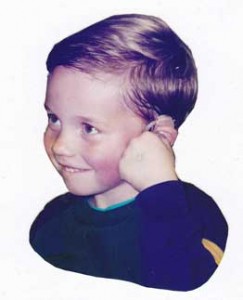 ability. If the child is a consistent hearing aid wearer, then consider the
ability. If the child is a consistent hearing aid wearer, then consider the
SPLogram or aided audiogram. If the child does not wear hearing aid(s) daily, then use the unaided audiogram.
2. What speech sounds can the child hear consistently? Plot the child’s hearing thresholds on the
Speech Spectrum Audiogram for Consonants to estimate his or her speech perception abilities when detecting sound from a close distance in a very quiet setting. A child cannot be expected to discriminate and comprehend sounds if they are not consistently perceived. Only thresholds representing the best hearing should be plotted, since that is the ear that will be used primarily to detect and discriminate soft sounds. This can be considered the child’s “hearing line.” Identify the speech sounds that will be: (a) most likely audible to the child (sounds above the hearing line), (b) detected in consistently by the child (on or very close to the hearing line), or (c) inaudible to the child (below the hearing line on the audiogram).
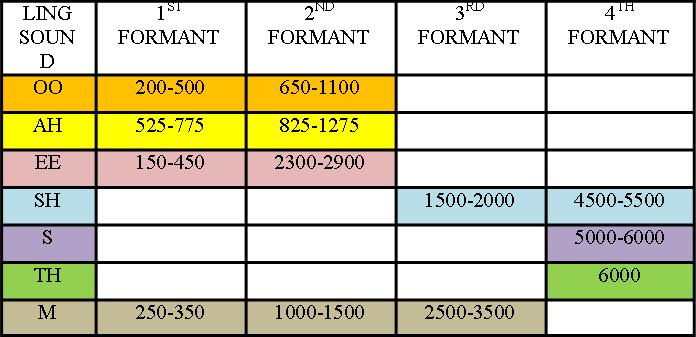 If the child’s audiogram is not available or is unreliable or you want to confirm the accuracy of these sound perception estimates, stand 4-6 feet from the child and ask him/her to repeat or signal when you say the Ling sounds at a typical conversational level. The child’s ability to repeat these sounds should generally reflect the hearing ability for the different pitch ranges and should agree with the sound audiogram. Clinically, the Ling sounds were chosen because /oo/ as in “moon” approximates 250 Hz, /a/ as in “mop” at 500 Hz, /ee/ as in “meat” at 1000 Hz, /sh/ at 2000 Hz and /s/ at 4000 Hz (Ling, 1989).
If the child’s audiogram is not available or is unreliable or you want to confirm the accuracy of these sound perception estimates, stand 4-6 feet from the child and ask him/her to repeat or signal when you say the Ling sounds at a typical conversational level. The child’s ability to repeat these sounds should generally reflect the hearing ability for the different pitch ranges and should agree with the sound audiogram. Clinically, the Ling sounds were chosen because /oo/ as in “moon” approximates 250 Hz, /a/ as in “mop” at 500 Hz, /ee/ as in “meat” at 1000 Hz, /sh/ at 2000 Hz and /s/ at 4000 Hz (Ling, 1989).

3. What is the child’s range of hearing in different situations?
Hearing is a distal sense that is affected by background noise and reverberation in the environment. It is important to consider the effect of distance on speech perception. Another way to think of this is to consider the size of the child’s “
listening bubble” or their range of hearing in different listening situations. If the child is very close to the speaker, is using an FM system, or it is very quiet, he or she may be able to detect more sounds than those suggested by the audiogram. If the listening environment is noisy or the child is at a distance greater than 4-6 feet, then most likely, he or she will not be able to perceive sounds as well as suggested by the audiogram. To estimate the child’s ability to perceive sound in a 1:1 listening situation, you can produce the Ling sounds (in quiet or with background noise) at 2-3 feet. Improvement in listening through the use of an FM system can be estimated by having the child repeat the Ling sounds in quiet from a distance of 4- 6 inches. Be careful not to let the child feel the air stream as you produce the sounds.
4. Where is the child on the hierarchy of development of auditory skills? Speech perception
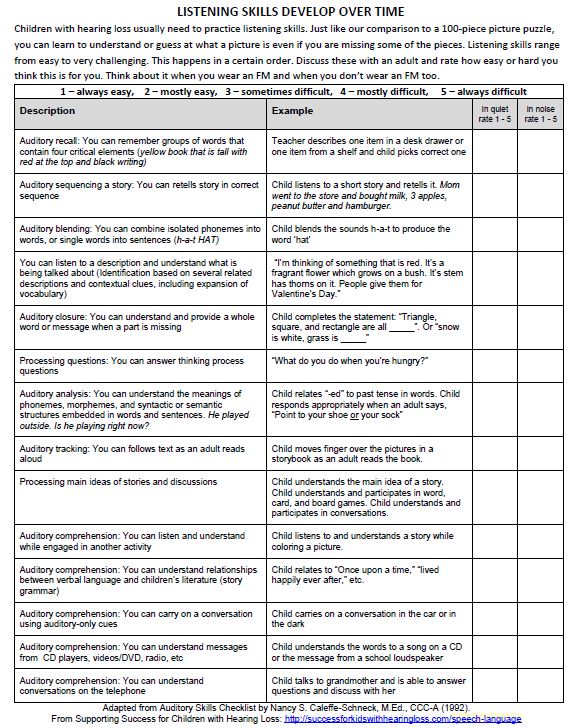 ability and the level of auditory skills will determine the degree to which spontaneous speech and language can be expected to emerge in the absence of a manual communication system. A child who does not perceive speech sufficiently to spontaneously develop age appropriate auditory skills will likely have speech and language delays. Consider the child’s level of auditory skills (detection, identification, discrimination, comprehension).
ability and the level of auditory skills will determine the degree to which spontaneous speech and language can be expected to emerge in the absence of a manual communication system. A child who does not perceive speech sufficiently to spontaneously develop age appropriate auditory skills will likely have speech and language delays. Consider the child’s level of auditory skills (detection, identification, discrimination, comprehension).
Listening Skills Develop Over Time may help you understand the various auditory skills. The majority of children who are hard-of-hearing will have sufficient residual hearing to detect most, if not all, speech sounds when amplified. Some sounds may be heard inconsistently and will be difficult to discriminate. Listening skills are developmental, based on consistent exposure and experience with sound.
5. Which speech sounds are the best targets for habilitation?
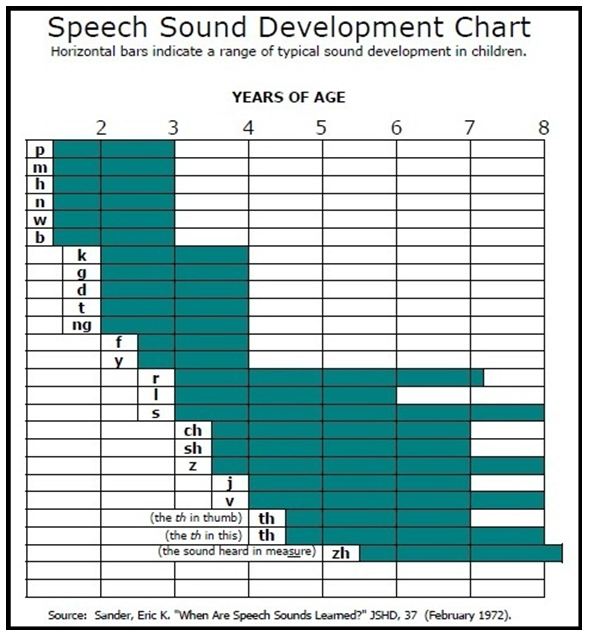 When analyzing the sound productions of children with hearing loss, first, be sure that the speech sounds are developmentally appropriate for the child’s age (
When analyzing the sound productions of children with hearing loss, first, be sure that the speech sounds are developmentally appropriate for the child’s age (
Speech Sound Development Chart), then differentiate between sounds that are within the child’s speech perception ability and sounds that are not. Elicit connected speech to determine a child’s speech proficiency. Emerging or misarticulated audible sounds would be the initial articulation targets chosen for habilitation (sounds above the hearing line on the sound audiogram). Speech sounds that are inconsistently audible would be the next articulation targets (sounds on or very near the hearing line). Inaudible speech sounds may be approached more efficiently through practice with computerized programs that monitor production, provide visual cues, and target prosody and loudness as well as phonology. The inaudible sounds are more challenging to the child and mentor since they must be approached through visual and proprioceptive feedback—systems that are less efficient than the auditory system for learning speech. However, many children with hearing loss have learned to articulate inaudible sounds as part of auditory-oral methods that capitalize on skills other than primarily audition.
6. Tap into higher order language skills, not just vocabulary. Language gaps often occur due to lack of language stimulation or fragmented perception of verbal communication. Evaluation of language ability is not necessarily straightforward. Children who are hard-of-hearing may do quite well on a vocabulary test— (e.g., Peabody Picture Vocabulary Test; Dunn & Dunn, 1981) and still have significant gaps in their word understanding due to a life time of hearing fragmented speech and missing incidental language. Therefore, traditional vocabulary tests tend to under estimate the significance of a language deficit in this
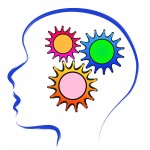
population. Higher order language tasks, such as problem solving, following age appropriate multi-step directions, repeating the critical elements of a story, or using specific words or concepts meaningfully, can reveal gaps in receptive language ability. Careful observations of the student within the active educational setting may provide the most critical information about the child’s daily language usage and comprehension. It is important to recognize that even if a test has been standardized on a population with hearing impairment, it still may lack relevance to the language tasks required of mainstreamed students with hearing impairments.
Information on pragmatics and children with hearing loss to appear on a future SSCHL webpage.
7. Gaps in language relate to the complexity of meaningfulness. Due to gaps in receptive language, the test performance of children with hearing loss could be inaccurately interpreted as a language processing disorder. This problem can be compared to one’s learning a second language as an adult, but not developing a robust vocabulary and sophisticated grammar. You could process the
conversational language that you had learned quite well, but the vocabulary or grammar you did not know could potentially sabotage your comprehension. The speed and accuracy of processing any conversation depends upon your world knowledge, which guides your expectations; your facility with the vocabulary, grammar, and conversational conventions of the language; and your ability to use context to infer meaning. Because the overriding concern in language learning is “meaningfulness,” simple vocabulary drills of isolated words are not effective in meeting a child’s needs to become a fluent communicator for social, as well as educational reasons.

8. Vocabulary is only useful in the larger context of life and learning. The acquisition of vocabulary and its nuances is a slow and additive process. The child must become a word mason, using known words as a foundation and building walls of vocabulary by adding new, similar words that intersect across content areas or by recognizing the multiple meanings of words that need to fit into more than one wall. Between each of these word bricks is a mortar, made up of syntactic forms and pragmatic functions. Meaning exists in context. Acquisition and comprehension of the richness of vocabulary is more reliant upon context than upon a single definition or an isolated sentence. The language of peers is ever changing and often produced in quick conversations in noisy environments. The acquisition of figurative language, idioms, and slang helps students become
participating members in their peer groups. This vocabulary is a prime target for habilitation. To identify these popular words, talk with and listen to children on the playground and in the halls. Role-play with the child with hearing loss to illustrate the meaning and appropriate context of these new words. Figurative language is especially important to school-aged children. Idioms, slang, metaphors, and other forms of figurative language add to the richness of our conversations and stories, and their usage often identifies the social status of the user (
idiom lists and activities, Idioms Checklists for Elementary and Secondary Students).
9. Simply missing endings may not be simple. Due to the tendency for children with hearing loss not to perceive word endings (morphology) and unstressed words or syllables, errors in the use of syntax and morphology are sometimes evident in writing and speaking (
Speech Production Characteristics article). These forms may be emerging and relatively easy to address through direct teaching of syntax forms (e.g., plural, past tense, possessives) or, they may involve more serious deficits or confusion that require lengthy and repetitive habituation methods. Morphological differences can be approached through contrastive procedures that underscore when and when not to use the endings. The use of contrastive procedures helps to add meaningfulness by providing context for the use of the endings.

10. Differentiate between sound-based and language-based reading problems
. Reading skills appear to be significantly related to phonemic awareness. Many, if not most, children who are hard-of-hearing develop some level of phonemic awareness, which allows relatively age appropriate word recognition or oral reading performance (i.e., one year delay). Reading comprehension tasks reflect an individual’s higher order language and cognitive abilities. If a child performs within the normal range on standard receptive language measures, but is subsequently found to perform poorly on language-based reading tasks (i.e., reading comprehension delays of 2+ years), this deficit should be an indication of the need for further investigation of language skills. Therefore, a low reading comprehension score could be a reflection of deficiencies in language, rather than a reading disorder.
11. Hearing loss can be an acoustic and comprehension barrier to accessing verbal instruction. If a child is having

difficulty following directions, take the time to clarify whether he or she under stands the concepts and vocabulary of directions or is having difficulty following directions because these words are not perceived across the distance of a
noisy classroom. A personal ear-level FM system or a desktop FM system improves ease of listening and increases understanding of teacher instruction. A glossary does not replace the experience of learning words naturally in incidental exposure. Consider how much of the vocabulary taught during an academic content unit may have been learned by class peers through overhearing in a variety of situations, rather than at school. Words should be used in many different ways and concepts should be described using many different words. In addition, some children can benefit from visually presenting word relationships via webs or highlighting words with similar meanings in paragraphs. Comparing and contrasting a child’s base of understanding with unknown language can make them feel empowered by how much they do know, and assist them in making connections between concepts.
12. A child’s needs are more complex than curriculums. Finally, language is alive and interactive; it is the connection that makes us peers and friends. Helping a child develop the skills to recognize his or her gaps, infer meaning, and feel okay about not knowing all the word possibilities is a task that cannot be instilled through drill, worksheets, or pluck-off-the-shelf curriculums. Flexibility, encouragement, caring, and using language from the child’s own world is the ticket for success with children who are hard-of-hearing.
References
Dunn, L. M., & Dunn, L. M. (1981). Peabody Picture Vocabulary Test— Revised. Circle Pines, MN: American Guidance Service.
Ling, D. (1989). Foundations of spoken language for hearing-impaired children. Washington, DC: A.G. Bell Association.
Stout, G, & van ert Windle, J (1992). Developmental approach to successful listening II. Houston, TX: Resource Point.
This information has been adapted from Karen L. Anderson and Donna I. Crowley: When Listening Carefully is Not Enough: 12 Steps to Approaching Speech Language Pathology Services for a Child that is Hard of Hearing. Perspectives on Hearing and Hearing Disorders in Childhood, 12(3), 33-37; ASHA Division 9.
For additional information on figurative language, refer to Later Language Development: The School-Age Years by Marilyn Nippold, Austin, Texas: PRO-ED, Inc., 1998.
